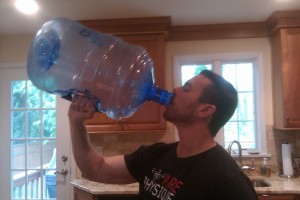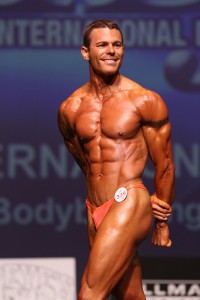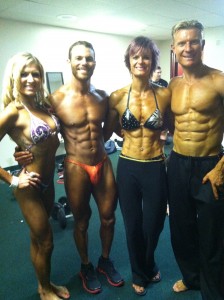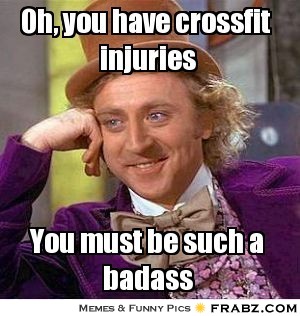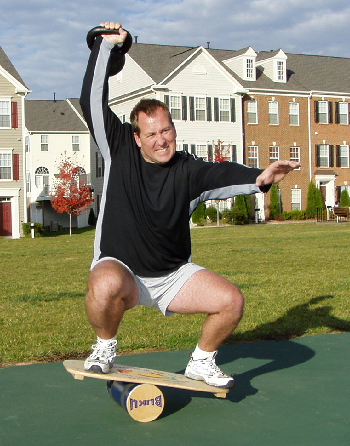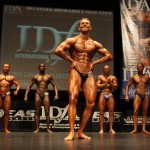By Daniel W. Nolin
“Focus is everything.” This was the opening sentence from one of six-time Mr. Olympia winner Dorian Yates’ articles. From the context from which he was speaking, he was correct. A trainee’s level of focus is one of the deciding factors in how far he will go in his exercise career. But what is focus? How is it used? Is focus the correct terminology to use for this mental state? These are questions that will be addressed in this article.
Aside from genetics and drug use, it is the ability to concentrate, not necessarily the ability to focus, which is a key factor that separates the professionals from the average trainee. Perhaps this is an exciting prospect for many trainees since their dreams were shattered upon the discovery that they either did not have the genetics to become a competitive bodybuilder (or athlete) or did not want to abuse anabolic steroids to get to that level. Granted, although the proper use of concentration will not compensate for poor genetics, it may help a trainee take his or her physique to a level never dreamed before.
WHAT IS FOCUS?
Being in focus is not the same thing as concentrating, although people use the terms ‘focus’ and ‘concentration’ interchangeably. And if an individual is talking casually there is nothing wrong with doing so. However, from a philosophical perspective the two are different, albeit, they do work best when used together. And so, let’s see what each one is and how a trainee can derive optimal benefits from both.
First, take a look at the concept of focus, a much more fundamental concept than concentration. To be in focus is to be in tune with reality. A focused individual is concerned with facts and not feelings, fantasy, or other peoples’ opinions.
Focus is such a fundamental aspect of volition that there is no step-by-step process by which one initiates focus. It is simply a volitional switch that can be turned on or left off. Focus must be maintained on a moment-by-moment basis. A trainee literally must reaffirm his focus every two seconds at minimum. The more consistently the choice to focus is made, the easier it becomes. Many individuals think that once a strong focus is established they can ‘coast’ for a while without negative consequences, but this is not true; either an individual is in focus or is not. What may seem like a comfortable coast is actually the beginning of a descent that will end up in a pit of chaos. Focus is what gives an individual control over his life, and there can be no substitutes.
It is also not true that there are different levels of focus. Either a trainee is in full focus or he is not; there is no middle ground. It may seem as if there are levels of focus since most individuals are not in focus consistently on a moment-by-moment basis. The measurement that should be considered is not the level of focus, but the consistency of time spent in focus. Meaning that if throughout the course of one minute an individual is in focus for thirty of the sixty seconds then that individual may reflect on that minute and feel that he was only half in focus. The actual truth was that at any given moment he was either in full focus or not.
Being in focus at the gym does not guarantee a good workout. What being in focus will guarantee is that a trainee will be fully aware that he is at the gym, and this means that while he is in focus his mind will not wonder into fantasy. It will not drift to other menial concerns or other people’s awareness of him. His mind will only be concerned with himself, where he is, what he is doing, and why he is doing it.
HOW TO APPLY FOCUS
Remember that focus is a much more general concept than term than concentration. It would be incorrect to tell a trainee to stay ‘focused’ on his workout, as that would be too specific and the term that should be used for such a statement would be concentration. Being in focus means being in touch with reality in general. When in focus an individual’s mind is aware of where he is, who he is, and why he is there.
To reiterate, being in focus does not mean an individual is focused on the specifics of a task at hand. It means that his mind is ‘in touch’ with reality. And so, when a trainee is in focus while he is at the gym his mind is clear, alert, and ready for action; he is fully aware of the equipment around him. With every piece of exercise equipment he looks at a flood of information that instantly is available to him. Being in a daze and not being cognizant of his surroundings as various thoughts float in and out of his awareness would be the opposite of being in focus.
The best method a trainee can use to get focused is for him to ask (what may seem like trivial questions): “Where am I? What piece of equipment am I going to use? Why this equipment instead of another?” He should ask of himself orientating questions that will make him more aware of his physical surroundings. A sure fire way to know that he is not in focus is if he is distant or even seems separated from the objects around himself. A trainee who is at the gym, yet seems distant from his physical surroundings is most likely not in focus.
Being in touch with concrete objects around one’s self is vital for sustaining focus. However, physical objects are not the total of reality: an individual’s consciousness is just as much a part of reality as the steel dumbbells in front of him. It is just as important for a trainee to orientate his mind to his own consciousness as it is orientate his mind to his surroundings. This means a trainee must be fully aware of what is going on in his head, or ‘consciously conscious, so that he will be able to guide it in the proper direction.
WHAT IS CONCENTRATION?
Concentration is the act of isolating one’s attention on a specific object, task, or aspect of consciousness. Anyone who has done any type of meaningful work in his or her life has had some experience with concentration.
An individual does not have to be in focus in order to concentrate, and vise versa. This means that an individual can concentrate on an object or act without being focused on reality, such as when he is engaged in a training routine that he knows to be irrational and unproductive, but is doing it very well.
Unlike focus, concentration is not merely a choice of ‘on’ or ‘off.’ There are varying degrees of concentration, even though there are no means of measuring these degrees at present. Currently, you can give your full and undivided attention to what is being read, or your concentration may be divided, the latter of which may be more appropriate if there is something in the oven, there are children playing nearby, etc.
HOW TO APPLY CONCENTRATION
Remember that concentration is the isolation of your awareness to something specific, in contrast with focus that is a much more fundamental concept. However when most people use the term focus it is actually concentration to which they are referring. Even though it may be misnamed, the concept of concentration is much more widely used in today’s culture.
What concentration means in practice at the gym is that an individual’s awareness is riveted on himself and his workout. It means that his attention does not wonder about to other concerns or events going on in the gym. If a group of people beside him is listening to a joke one of them is telling, he is not diverted by it.
Unlike focus, which is either ‘on’ or ‘off,’ there are different levels of concentration. At present there is no objective way to measure different levels concentration. However, it is observable through introspection, in that one can heighten or lower the intensity of concentration at any moment.
FURTHER UNDERSTANDING THE DIFFERENCE BETWEEN FOCUS AND CONCENTRATION
The idea that focus and concentration do not pertain to the same mental state may be so new to some that further differentiation may be warranted. The best way to see the difference between the two concepts is to isolate each from the other. The following are examples of being in focus without concentrating and concentrating without being in focus. An individual can be at the gym in full focus, but yet not concentrate on his workout. The clearest example would be a trainee fully aware of where he is and why, but having a nagging problem from his work day, at the peripheral of his mind that will not go away. Or perhaps a more common example is a trainee being in focus but not concentrating on anything in particular; simply moving from exercise to exercise, in focus, but doing so out of habit and routine.
Concentrating on a workout while being unfocused is a more common phenomenon. It can be done by concentrating on the particulars of a given exercise while not focusing on the routine as a whole. A trainee may be in full concentration when it comes to the concentric, eccentric, tension time, etc., but will ignore other factors that he knows to be important, such as regulating the volume and frequency.
THE PERFECT BALANCE
By now it should be apparent that to live a long productive fitness lifestyle there needs to be a harmony between focus and concentration. A trainee should be fully aware of himself, his surroundings, and why he is at the gym. As well, he should keep his mind isolated on each individual exercise and not have his mind wondering to other issues during the middle of a set.
The ideas discussed in this article are not new; they are discussed in philosophy classrooms around the globe. But perhaps they are new to the reader of this article. It should be obvious that the basic concepts discussed herein can be applied to almost any human endeavor, yet it is arguable that the amount of focus and concentration needed to be a successful trainee is higher than that of many other goals. Using rational high intensity training principles in exercise is one of the most physically excruciating activities that can be done. Yet learning how to harness the benefits that a properly focused and concentrated mind can provide is an invaluable ability that can help a trainee reach his or her fitness goals.
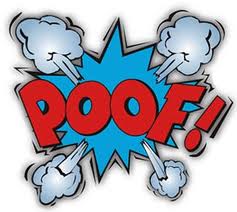 The two weeks were comprised of my wedding and honeymoon so by no means do I kick myself over all the eating and drinking I did. Heck, Corrie-Beth and I spent 7 of our 10 day honeymoon in Napa Valley and Sonoma so you better believe we were drank a lot of wine! And the meals were pretty damn good too.
The two weeks were comprised of my wedding and honeymoon so by no means do I kick myself over all the eating and drinking I did. Heck, Corrie-Beth and I spent 7 of our 10 day honeymoon in Napa Valley and Sonoma so you better believe we were drank a lot of wine! And the meals were pretty damn good too.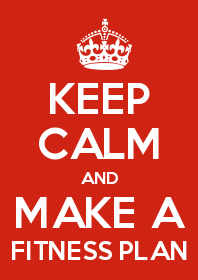 The idea of starting over can be a little demoralizing if you don’t have the proper mindset. As I said, I would never give up all the great breakfast, lunch, dinners, wine, beer, and spirits I indulged in over the two week wedding/honeymoon period. In fact I had planned for it. All the dieting I had done over those three prior months was in anticipation of all I would do and was a way of mitigating the damage. I knew from the very beginning that at some point I was going to have to “start over”. Since it is exactly what I expected it eliminates the pain of feeling like “I blew it”.
The idea of starting over can be a little demoralizing if you don’t have the proper mindset. As I said, I would never give up all the great breakfast, lunch, dinners, wine, beer, and spirits I indulged in over the two week wedding/honeymoon period. In fact I had planned for it. All the dieting I had done over those three prior months was in anticipation of all I would do and was a way of mitigating the damage. I knew from the very beginning that at some point I was going to have to “start over”. Since it is exactly what I expected it eliminates the pain of feeling like “I blew it”.
